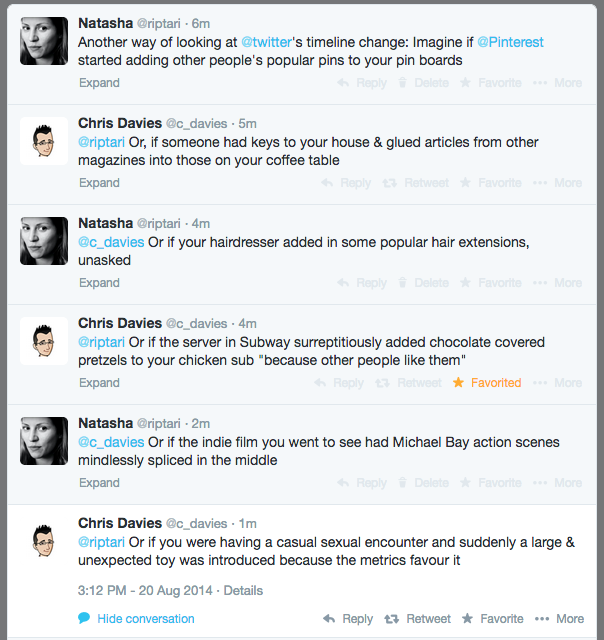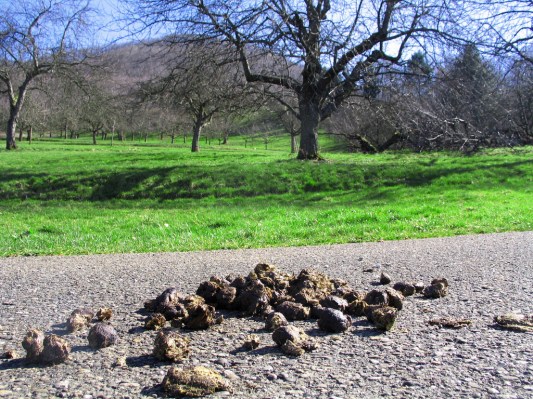If your Twitter stream is looking a little more crap random than usual there’s a concrete reason for that: Twitter has made a behind-the-scenes change which means it’s algorithmically adulterating the mix of content you see. Not that they’re putting it like that, of course.
The specific change in how your Twitter timeline operates allows for the company to inject additional content into your feed from other users you don’t follow. This is in addition to promoted tweet advertising content — you still get that thrust into your feed too.
Yesterday the company added the following paragraph to a Help Center page which details exactly how far it’s moving the goal posts here:
Additionally, when we identify a Tweet, an account to follow, or other content that’s popular or relevant, we may add it to your timeline. This means you will sometimes see Tweets from accounts you don’t follow. We select each Tweet using a variety of signals, including how popular it is and how people in your network are interacting with it. Our goal is to make your home timeline even more relevant and interesting.
So basically this change means tweets from people you’re not interested in may now show up in your Twitter feed. And judging by the popularity reference, at least some of the content being algorithmically injected is exactly the sort of mainstream trivia that makes Facebook so uninteresting to a large swathe of Twitter users (myself included). And indeed the sort of content that populates Twitter’s Discover feed — aka ‘the feed that no-one reads’. Except now some of that crap is being thrust in front of your eyeballs, mingled with the tweets you did want to read.
Twitter’s focus on popularity as a selection criteria for injecting tweets evidently also means that tweets marked as favorites by other users can now appear in your timeline — a change that has already triggered a backlash of complaints, as noted by an earlier Guardian report.
Here Twitter has spectacularly failed to appreciate that the favorite function is used in multiple ways; not just to signify that a particular piece of content is well liked. Twitter users lean on the function to act as a marker to themselves to read something later or just to bookmark a tweet for later reference. Or as a meta communication to another Twitter user — to silently say the equivalent of ‘thanks’ or ‘noted’ or ‘I saw that’ or ‘yes’ or ‘lol’. And now all those meta communications run the risk of being broadcast to others they weren’t intended for — destroying the layered value of the favorite function.
But presumably that’s what Twitter wants — and this is the company attempting to force the favorite function to become a Facebook-style ‘like’ button so it acts as an individual preference marker that can be tracked and monetized.
Twitter is famous for tweaking its product and doing A/B tests to try out tweaks to see how loudly the Twittersphere squawks in protest — such as when it added thin blue lines to thread conversations, reversing the flow of the timeline in order to make it easier for newcomers to navigate conversations. Those blue lines showed up in Twitter tests before being rolled out to everyone. Other tweaks have been tested and rejected. But don’t get your hopes up; TechCrunch understands this latest ‘injected tweets’ shift is not a trial — it’s a done deal.
This change is also BS. I say that as a long time Twitter user with 21,600+ tweets to my name over six years using the service. If it’s stuff from someone I don’t follow, then — sorry, Twitter — to me that stuff is probably crap. If I wanted to eyeball a stream of populist rubbish I’d be using Facebook. Or, as one of my TC colleagues judiciously put it, “just because something is ‘popular’ does not mean it’s ‘relevant'”.
Twitter declined to answer a series of questions I put to it about this change — including whether it will offer an opt out — saying only that it updated its Help Center yesterday and adding: “We don’t have anything additional to share at this stage.”
The underlying impetus for Twitter polluting users’ timelines with populist content is of course its ongoing need to grow usage of the service. While its latest set of financial results boosted its stock, the company’s share price took a battering in its first two financial reports — diving to a record low in May when a big shareholder lock-in expired.
How do you grow really, really big — big enough to keep the shareholders happy? By running a celebrity-packed bandwagon right down the middle of the road of course. Too bad you’re going to annoy the hell out of long-time users who found value in a service exactly because it took a different path. A small hardcore of loyal users don’t please shareholders.
This injected tweets shift is just the latest in a series of populist moves for Twitter as a publicly traded company. Another mainstream change it foisted on users earlier this year was to automatically push photo previews in users’ timelines — turning a dense 140-character info-stream into something that more closely resembles the multimedia Facebook news feed. After all, pretty pictures catch the mainstream eye.
The photo preview change does at least have an opt out on mobile. But Twitter’s latest populist shift has no direct opt-out within its own products (third-party clients may be able to offer a workaround for a while, until Twitter updates its API) — making a mainstream-flavoured timeline the new world order for the service.
And Twitter one step closer to becoming Facebook.

Update: TechCrunch understands that the feature has so far only been implemented on Twitter’s iOS and Android mobile apps so one way to avoid any algorithmically determined content adulterating your timeline is to use another mobile client, such as Tweetbot, or to use Twitter’s web interface (or another third party web client such as Hootsuite).
